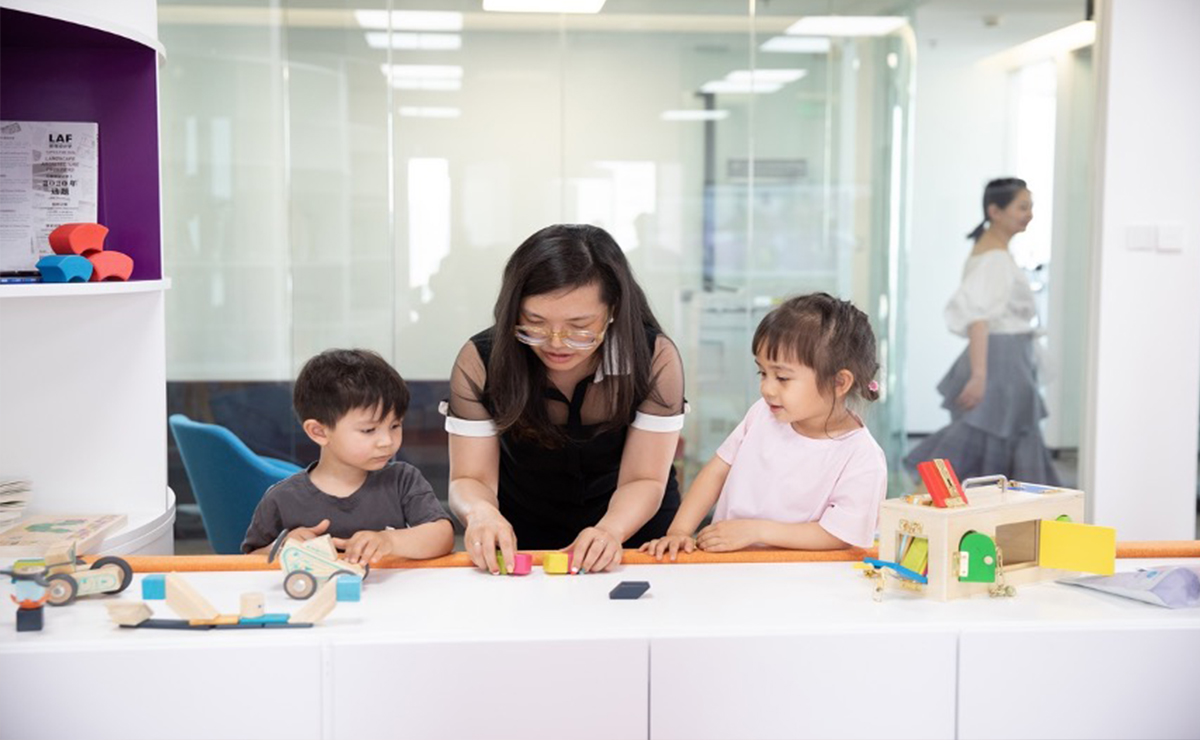Stella Christie studies how children and great apes reason. She has concluded that human society is built on the back of our relational mind.
Few things can be understood in isolation. “Number 42 is understood as the successor of 41, or as the result of 6 times 7. We can’t think of the shape or color of 42 but instead, we must relate 42 to something else,” points out Stella Christie, professor and research chair at the Tsinghua Laboratory of Brain and Intelligence.

Stella Christie (centre) leads cutting-edge research on the ‘relational mind’ at the Tsinghua Laboratory of Brain and Intelligence Child Cognition Center, one of the largest cognitive developmental laboratories in Asia.
Relational thinking lies at the core of human cognition, she explains. “Mathematics requires relational thinking, and so does language, map reading, musical enjoyment, and social behavior.” Speaking a language requires one to put words in the right order and relationships, for example. Likewise, social behavior depends on social relationships—we help friends but not foes.
But are humans special in this regard? To check whether the importance of relationality is a uniquely human trait, Christie compared relational thinking between human children and other great apes—bonobos, chimpanzees, and orangutans1. Human DNA and brain structure are very similar to those of other great apes yet we are the only ones who speak languages, build cities and have culture. Is the critical difference our cognition—our relational mind? The answer, Christie found, is both yes and no.
To explore this, Christie asked three-year-old children and great apes to do a spatial mapping task: after seeing an object hidden in one stack of boxes, participants had to find the object in the same relational position, such as the top, middle, bottom, in a different stack of boxes. “Initially, three-year-olds, chimpanzees, and bonobos had no problem finding the hidden object,” says Christie. But later, when the stacks of boxes were given colors that mismatched in relational position, children were worse than other great apes at finding the hidden object.
This finding surprised many researchers in the field. It had been widely assumed that humans would be more sensitive to relational cues while non-human animals would respond better to the surface features of objects, such as color. But Christie’s study showed the opposite: children and great apes are more-or-less comparable in their sensitivity to relations without other input, but it was the humans who responded more strongly to surface features. “Contrary to expectation, we found that human children responded to more concrete input than great apes,” summarizes Christie.

Children and families are tested both online and at the Tsinghua Laboratory of Brain and Intelligence in Beijing. The lab now has a database of cognitive developmental information gathered from 18,000 families with young children. To sign up to participate or to get in touch to join or collaborate with the lab, click here .
The path from the concrete to the abstract
But adult humans are manifestly more relationally complex than great apes; humans compose sonatas and play tic-tac-toe. What changes between childhood and adulthood to make humans more adept in relational reasoning? How do we learn to think more relationally?
One catalyst of relational thinking is language. “Language makes it easier to recognize a previously seen relation in new settings,” explains Christie. “Language is like a gift wrapper: take a mundane rock and wrap it prettily, now the rock is more easily found and has more value. Likewise, a relational concept becomes more portable once it has a name.”
But language is even more powerful than that. In a 2014 study, Christie and her colleagues found that two-year-olds who initially could not match symbols, let’s say oo to xx, were able to do so after oo was given a nonsense name2. Simply calling oo truffet (a name without meaning) allowed two-year-olds to find another truffet xx.
How could a meaningless label bring about a profound change of thought in two-year-olds? Christie explains that labels invite children to compare, allowing them to think about relations.
“When we compare, we scan for potential relations. As a result, we think of common relations that were not obvious prior to the comparison,” Christie explains. That’s why even a meaningless label can change thinking.
So, although human children are initially more concrete, that concreteness—attention to surface features—gives them multiple opportunities to compare. Over time, the accumulated benefit of many comparisons, compounded with the relationally abstract effect of language, allows them to develop superior relational thinking. “Our relational prowess is learned, not inborn,” Christie concludes.

Stella Christie is a professor and research chair at the Tsinghua Laboratory of Brain and Intelligence.
The relational mind in education, science, industry and society
Christie’s discoveries have profound implications for education, as well as for nurturing creativity and innovation in society.
During education, students sometimes struggle to understand concepts because they lack relational understanding. For instance, primary school children learning mathematics sometimes have difficulty solving math problems in a word format—say ‘Lili has two apples to be shared among four friends. How many apples does each friend get?’—even though they just solved the problem numerically as 2/4 = ?.
Difficulties arise for students because they do not see that these are the same problem and solution. Indeed, research shows that when math teachers use comparison—which Christie discovered to be a catalyst for relational thinking3—students learn math better. For example, teachers may compare two different correct solutions, such as two apples and a banana or one apple and two bananas, to the basic math question. Whether learning mathematics, geography, chemistry, or physics, relational thinking can help students grasp that the various concepts they are learning cohere systematically, rather than being a scattered zoo of things to be remembered.
Relational thinking helps more than just novices. Scientists and innovators alike, from Kepler, Bohr and Darwin to Google founders Sergey Brinn and Larry Page, have used analogical reasoning—mapping relations between events—to innovate.
“Relational thinking is the foundation for creativity and innovation, as it allows the mind to map the structure of familiar things to new things,” explains Christie. A famous example is Bohr’s model of the atom, in which he likened orbiting electrons—completely unknown at that time—to planets circling the Sun, which was at the time a concept familiar to most. Likewise, Brinn and Page got the idea for a search engine from the structure of academic citations, which gave birth to Google.
“We often don’t notice similarities between relations,” Christie says. “Maybe that’s why we’re not all innovators and scientists.” But we can learn to do this, Christie’s research shows. To become a better relational thinker, a person needs to be in the habit of comparing, says Christie. “If you compare frequently, you will see more relations and more similarities between relations,” she points out.
Whether comparing different approaches in interdisciplinary science or different ways of going up or down a slide in children’s play, a relational mind may be the key to innovation.
For more information, visit Tsinghua Brain and Intelligence Laboratory of Tsinghua University’s webpage .
References
1. Christie, S., Gentner, D., Call, J., & Moritz Haun, D.B. Sensitivity to relational similarity and object similarity in apes and children Current Biology 26(4), 531–535 (2016) doi: 10.1016/j.cub.2015.12.054
2. Christie, S., & Gentner, D. Language helps children succeed on a classic analogy task Cognitive Science 38(2), 383-397 (2014) doi: 10.1111/cogs.12099
3. Christie, S., Gao, Y., & Ma, Q. Development of analogical reasoning: A novel perspective from cross‐cultural studies Child Development Perspectives 14(3), 164-170 (2020) doi: 10.1111/cdep.12380
Editor: Guo Lili